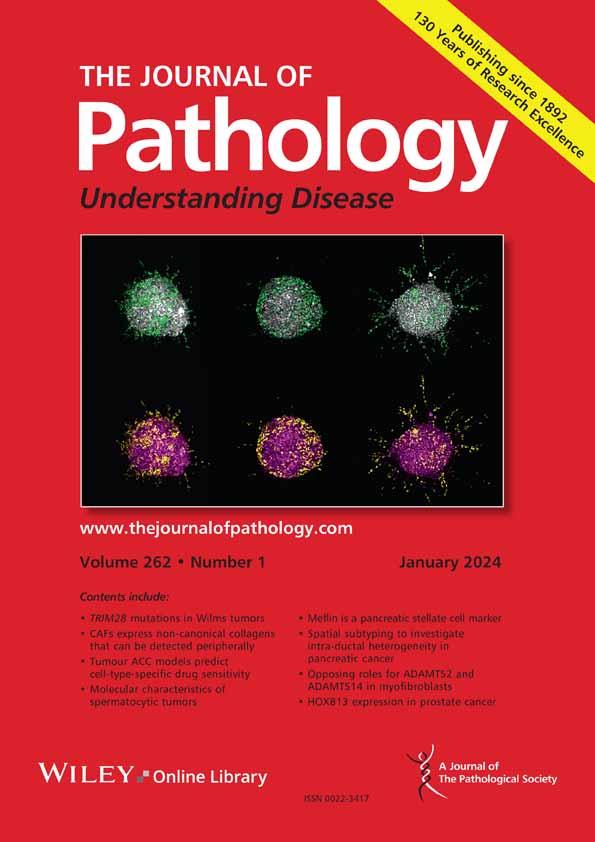Tuan Vo, P Prakrithi, Kahli Jones, Sohye Yoon, Pui Yeng Lam, Yung-Ching Kao, Ning Ma, Samuel X Tan, Xinnan Jin, Chenhao Zhou, Joanna Crawford, Shaun Walters, Ishaan Gupta, Peter H Soyer, Kiarash Khosrotehrani, Mitchell S Stark, Quan Nguyen
下载PDF
{"title":"评估空间测序和成像方法,以捕获存档的癌症组织的分子和病理异质性。","authors":"Tuan Vo, P Prakrithi, Kahli Jones, Sohye Yoon, Pui Yeng Lam, Yung-Ching Kao, Ning Ma, Samuel X Tan, Xinnan Jin, Chenhao Zhou, Joanna Crawford, Shaun Walters, Ishaan Gupta, Peter H Soyer, Kiarash Khosrotehrani, Mitchell S Stark, Quan Nguyen","doi":"10.1002/path.6383","DOIUrl":null,"url":null,"abstract":"<p>Spatial transcriptomics (ST) offers enormous potential to decipher the biological and pathological heterogeneity in precious archival cancer tissues. Traditionally, these tissues have rarely been used and only examined at a low throughput, most commonly by histopathological staining. ST adds thousands of times as many molecular features to histopathological images, but critical technical issues and limitations require more assessment of how ST performs on fixed archival tissues. In this work, we addressed this in a cancer-heterogeneity pipeline, starting with an exploration of the whole transcriptome by two sequencing-based ST protocols capable of measuring coding and non-coding RNAs. We optimised the two protocols to work with challenging formalin-fixed paraffin-embedded (FFPE) tissues, derived from skin. We then assessed alternative imaging methods, including multiplex RNAScope single-molecule imaging and multiplex protein imaging (CODEX). We evaluated the methods’ performance for tissues stored from 4 to 14 years ago, covering a range of RNA qualities, allowing us to assess variation. In addition to technical performance metrics, we determined the ability of these methods to quantify tumour heterogeneity. We integrated gene expression profiles with pathological information, charting a new molecular landscape on the pathologically defined tissue regions. Together, this work provides important and comprehensive experimental technical perspectives to consider the applications of ST in deciphering the cancer heterogeneity in archived tissues. © 2025 The Author(s). <i>The Journal of Pathology</i> published by John Wiley & Sons Ltd on behalf of The Pathological Society of Great Britain and Ireland.</p>","PeriodicalId":232,"journal":{"name":"The Journal of Pathology","volume":"265 3","pages":"274-288"},"PeriodicalIF":5.2000,"publicationDate":"2025-01-23","publicationTypes":"Journal Article","fieldsOfStudy":null,"isOpenAccess":false,"openAccessPdf":"https://onlinelibrary.wiley.com/doi/epdf/10.1002/path.6383","citationCount":"0","resultStr":"{\"title\":\"Assessing spatial sequencing and imaging approaches to capture the molecular and pathological heterogeneity of archived cancer tissues\",\"authors\":\"Tuan Vo, P Prakrithi, Kahli Jones, Sohye Yoon, Pui Yeng Lam, Yung-Ching Kao, Ning Ma, Samuel X Tan, Xinnan Jin, Chenhao Zhou, Joanna Crawford, Shaun Walters, Ishaan Gupta, Peter H Soyer, Kiarash Khosrotehrani, Mitchell S Stark, Quan Nguyen\",\"doi\":\"10.1002/path.6383\",\"DOIUrl\":null,\"url\":null,\"abstract\":\"<p>Spatial transcriptomics (ST) offers enormous potential to decipher the biological and pathological heterogeneity in precious archival cancer tissues. Traditionally, these tissues have rarely been used and only examined at a low throughput, most commonly by histopathological staining. ST adds thousands of times as many molecular features to histopathological images, but critical technical issues and limitations require more assessment of how ST performs on fixed archival tissues. In this work, we addressed this in a cancer-heterogeneity pipeline, starting with an exploration of the whole transcriptome by two sequencing-based ST protocols capable of measuring coding and non-coding RNAs. We optimised the two protocols to work with challenging formalin-fixed paraffin-embedded (FFPE) tissues, derived from skin. We then assessed alternative imaging methods, including multiplex RNAScope single-molecule imaging and multiplex protein imaging (CODEX). We evaluated the methods’ performance for tissues stored from 4 to 14 years ago, covering a range of RNA qualities, allowing us to assess variation. In addition to technical performance metrics, we determined the ability of these methods to quantify tumour heterogeneity. We integrated gene expression profiles with pathological information, charting a new molecular landscape on the pathologically defined tissue regions. Together, this work provides important and comprehensive experimental technical perspectives to consider the applications of ST in deciphering the cancer heterogeneity in archived tissues. © 2025 The Author(s). <i>The Journal of Pathology</i> published by John Wiley & Sons Ltd on behalf of The Pathological Society of Great Britain and Ireland.</p>\",\"PeriodicalId\":232,\"journal\":{\"name\":\"The Journal of Pathology\",\"volume\":\"265 3\",\"pages\":\"274-288\"},\"PeriodicalIF\":5.2000,\"publicationDate\":\"2025-01-23\",\"publicationTypes\":\"Journal Article\",\"fieldsOfStudy\":null,\"isOpenAccess\":false,\"openAccessPdf\":\"https://onlinelibrary.wiley.com/doi/epdf/10.1002/path.6383\",\"citationCount\":\"0\",\"resultStr\":null,\"platform\":\"Semanticscholar\",\"paperid\":null,\"PeriodicalName\":\"The Journal of Pathology\",\"FirstCategoryId\":\"3\",\"ListUrlMain\":\"https://pathsocjournals.onlinelibrary.wiley.com/doi/10.1002/path.6383\",\"RegionNum\":2,\"RegionCategory\":\"医学\",\"ArticlePicture\":[],\"TitleCN\":null,\"AbstractTextCN\":null,\"PMCID\":null,\"EPubDate\":\"\",\"PubModel\":\"\",\"JCR\":\"Q1\",\"JCRName\":\"ONCOLOGY\",\"Score\":null,\"Total\":0}","platform":"Semanticscholar","paperid":null,"PeriodicalName":"The Journal of Pathology","FirstCategoryId":"3","ListUrlMain":"https://pathsocjournals.onlinelibrary.wiley.com/doi/10.1002/path.6383","RegionNum":2,"RegionCategory":"医学","ArticlePicture":[],"TitleCN":null,"AbstractTextCN":null,"PMCID":null,"EPubDate":"","PubModel":"","JCR":"Q1","JCRName":"ONCOLOGY","Score":null,"Total":0}
引用次数: 0
引用
批量引用






 求助内容:
求助内容: 应助结果提醒方式:
应助结果提醒方式:


